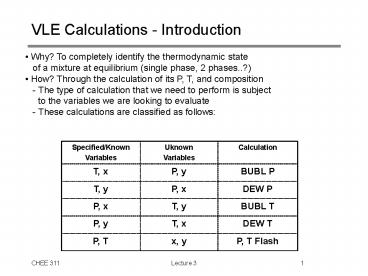VLE Calculations Introduction PowerPoint PPT Presentation
1 / 15
Title: VLE Calculations Introduction
1
VLE Calculations - Introduction
- Why? To completely identify the thermodynamic
state - of a mixture at equilibrium (single phase, 2
phases..?) - How? Through the calculation of its P, T, and
composition - - The type of calculation that we need to
perform is subject - to the variables we are looking to evaluate
- - These calculations are classified as follows
2
VLE Calculations Introduction (contd)
- As we are going to see later in the course, the
aforementioned - VLE calculations are also applicable to
non-ideal or/and - multi-component mixtures
- For now, we are going to employ them only for
the calculation - of the state and composition of binary and
ideal mixtures - The calculations revolve around the use of 2 key
equations - 1) Raoults law for ideal phase behaviour
- 2) Antoines Equation
(1)
(2)
3
BUBL P Calculation (T, x1 known)
- - Calculate and from Antoines
Equation - For the vapour-phase composition (bubble) we can
write - y1y21
(3) - Substitute y1 and y2 in Eqn (3) by using
Raoults law -
(4) - - Re-arrange and solve Eqn. (4) for P
- Now you can obtain y1 from Eqn (1)
- Finally, y2 1-y1
4
DEW P Calculation (T, y1 known)
- - Calculate and from Antoines
Equation - For the liquid-phase composition (dew) we can
write - x1x21
(5) - Substitute x1 and x2 in Eqn (5) by using
Raoults law -
(6) - - Re-arrange and solve Eqn. (6) for P
- Now you can obtain x1 from Eqn (1)
- Finally, x2 1-x1
5
BUBL T Calculation (P, x1 known)
- Since T is an unknown, the saturation pressures
for the - mixture components cannot be calculated
directly. Therefore, - calculation of T, y1 requires an iterative
approach, as follows - Re-arrange Antoines equation so that the
saturation temperatures - of the components at pressure P can be
calculated -
(7) - Select a temperature T so that
- Calculate
- Solve Eqn. (4) for pressure P
- If , then PP If not, try
another T-value - Calculate y1 from Raoults law
6
DEW T Calculation (P, y1 known)
- Same as before, calculation of T, x1 requires an
iterative approach - Re-arrange Antoines equation so that the
saturation temperatures - of the components at pressure P can be
calculated from Eqn. (7) - - Select a temperature T so that
- Calculate
from Antoines Eqn. - Solve Eqn. (6) for pressure P
- If , then PP If not, try
another T-value - Calculate x1 from Raoults law
7
P, T Flash Calculation
- - Calculate and from Antoines
Equation - Use Raoults law in the following form
-
(8) - - Re-arrange and solve Eqn. (8) for x1
- Now you can obtain y1 from Eqn (1), i.e.,
8
Example
- Assuming Roults Law to be valid, prepare
- a Pxy diagram for T90oC, and
- a Txy diagram for P90 kPa
- for a mixture of 1-chlorobutane (1)
/chlorobenzene (2) - Antoine Coefficients
9
Construction of Pxy diagrams
- The construction of Pxy diagram requires
multiple P, T, Flash - calculations, each one of which provides a set
of equilibrium y1, x1 - values for a given value of pressure (under
constant T) - The results can be tabulated as shown below
10
Example (a) Generation of Pxy Data
Slides 1-4 (current lecture) correspond to the
solution of the example problem presented in
Lecture 3 (Slide 10)
11
Example (a) Construction of a Pxy Plot
12
Construction of Txy diagrams
- The construction of Txy, diagram requires
multiple P, T, Flash - calculations, each one of which provides a set
of equilibrium y1, x1 - values for a given value of temperature (at
fixed P) - The results can be tabulated as shown below
13
Example (b) Generation of Txy Data
14
Example (b) Construction of a Txy Plot
15
What do we need to know so far?
- How to use the Phase Rule (F2-pN)
- How to read VLE charts
- - Identify bubble point and dew point lines
- - Read sat. pressures or temperatures from the
chart - - Determine the state and composition of a
mixture - How to perform Bubble Point, Dew Point, and
P,T-Flash calculations - - Apply Raoults law
- - Apply Antoines equation
- How to use the Lever Rule (graphically or
numerically) - How to construct VLE (Pxy or Txy ) charts for
ideal mixtures

